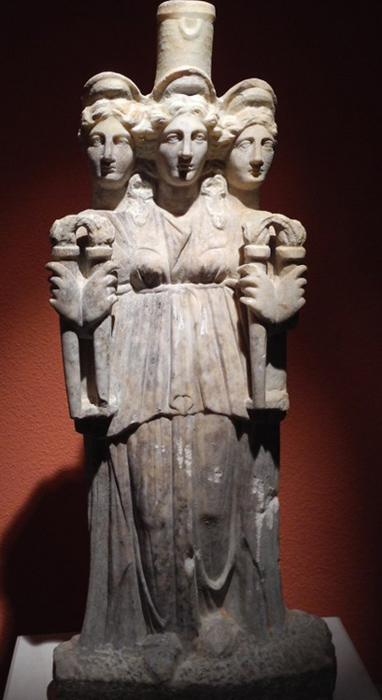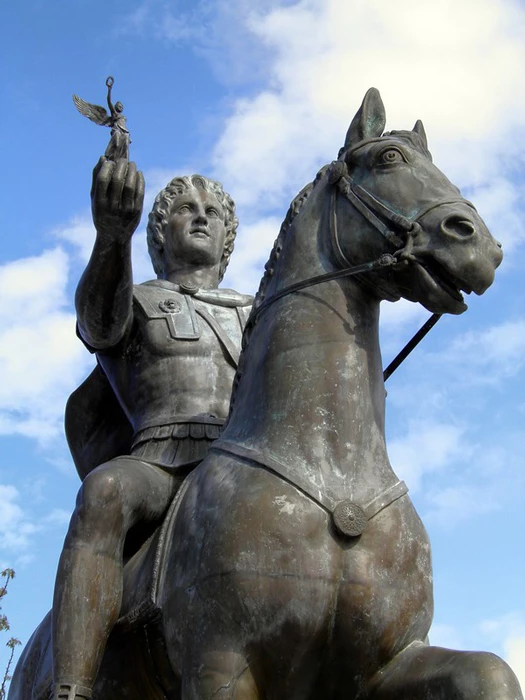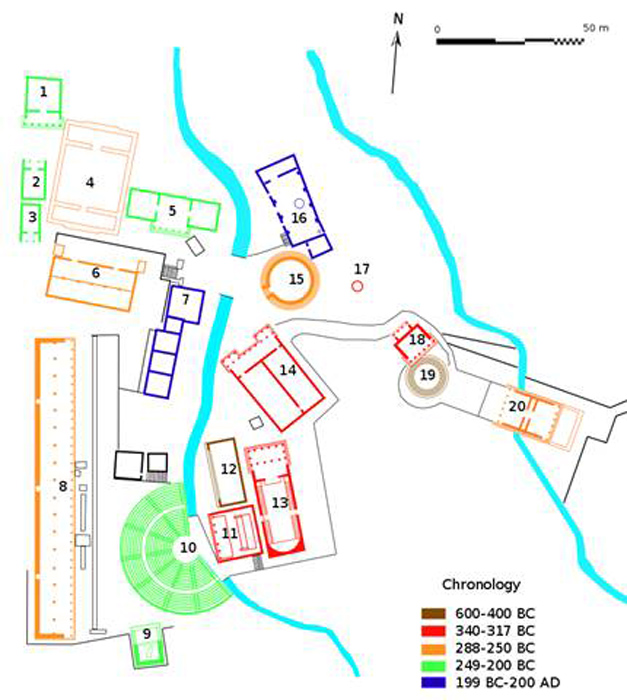The Greek pantheon of gods had many members. Not all were universal gods, such as Zeus or Poseidon, instead being tied to a specific place or niche activity. And not all were universally understood: there were cults of secret gods as well.
The Cabeiri or Cabiri were one such example of this secrecy in worship. This group of strange chthonic (those who dwell beneath the earth) deities were worshipped in a mystery cult, and were closely associated with Hephaestus, the blacksmith of the gods.
Centered in the north Aegean islands of Lemnos and possibly Samothrace (at the Samothrace temple complex) and Thebes, east of Greece, much of this cult is not fully understood. It seems to draw on pre-Greek or other non-Greek elements from around the Mediterranean or even further afield.
Elements from older cultures as diverse as the Thracians, Tyrrhenians, Pelasgians, Phrygians, and the mighty Hittites were fused together in this mystery cult. Why these cultures contributed to the Cabeiri remains mysterious.
The Lemnian cult was always limited to the island of Lemnos. However, the Samothracian mystery cult, apparently associated with worship of the Cabeiri, expanded fast throughout the Greek world, even ultimately being initiated into Roman society.
The Sanctuary of the Great Gods, also known as the Samothrace Temple Complex, is one of the most important Pan-Hellenic religious sanctuaries. Located on the island of Samothrace, it was built close to the west of the city of Samothrace’s ramparts, although it was still independent, as evidenced by the city sending ambassadors to the temple during festivals.
The Cabeiri Deities
At its heart the Cabeiri were a group of gods who were worshipped by the initiated. However the identities of these gods are not so easy to pin down, and any attempt to reconstruct the mysteries of the cult are limited by its secrecy.

For instance, we know of twin gods, known as daimones, who oversaw the orgiastic dances of Samothrace in honor of the fertility goddess Demeter, her daughter Persephone, and the divine witch Hekate. The pair were well-known metalworkers, the dwarfish sons of the god Hephaestus, who worked at their father’s Lemnian forge.
The daimones, like their mother Kabeiro, were sea-divinities who aided sailors in peril. In one version the Cabeiri were apparently three in number, but two of the brothers killed the third. The penis of Zagreus, who had been mutilated by the Titan-gods, was later found by the pair and placed in a central position on the Altar of the Mysteries at Samothrace.
- The Ogdoad: When Amun Ruled the Gods of Egypt
- The Mystery of the Pleiades: Where is the Seventh Sister?
However the identities of the other gods, and there were other gods, worshipped there were a secret. Offerings were made simply to “the gods” but their identity was never recorded, and neither were the initiation ceremonies to learn their secrets.
Archaeologists researching the apparent ancient sources for the Cabeiri repeatedly find two figures at the center of the cult, but their identity varies. As well as the sons of Hephaestus, there is the old man Axiocersus and his son, Cadmilus, or a pair of women, Axierus and Axiocersa.
How these central pairings interlink is unclear and apparently a secret only for the initiated. Did they replace each other as the cult evolved? Were they tied to specific sites, as the sanctuary on Lemnos would seem to suggest? Were they all a part of a secret pantheon?
The ancient borrowings even seem to extend to the gods themselves. Kadmilus, or Kasmilos, another of the Cabeiri who was frequently shown as a young child, was linked to Camillus, an old Latin word for a boy-attendant in a cult. This could be a word borrowed from the Etruscans who lived on the Italian peninsula before the Romans, as could the figure of Kadmilus himself.
The Cabeiri’s name is also apparently a reference to Mount Kabeiros, a mountain that is closely identified with the Phrygian Mother Goddess. Was she one of the Cabeiri as well?
The Initiates
The cult of the Cabieri, perhaps in part due to its mystery, was revered throughout ancient Greece. The historian Herodotus, one of the few to have left behind clues to the nature of the mysteries, the Spartan leader Lysander, and several Athenians were all initiates.
Plato and Aristophanes both reference the temple complex in their writings, and after Alexander the Great’s father Phillip II’s investiture, it became a Macedonian national sanctuary. During the Hellenistic period Alexander’s successors competed to outdo each other’s generosity and the cult became wealthy and powerful.

The sanctuary was available to anybody who chose to worship the Great Gods, but access to buildings dedicated to the mysteries was reserved for initiates. A priestess, known as a sybil and apparently seen as a prophetess, presided over these rituals and ceremonies as a service to the people.
Perhaps it was the ancient and foreign feel to the cult which attracted people. The Samothracians, like the Trojans and Pelasgians, were originally non-Greeks, and they used a foreign language in the temple until Julius Caesar’s time. There were also eminently practical benefits, for instance seamen were promised safety and prosperity if they completed an initiatory mystery presented by Samothrace.
The secrets of these mysteries have mostly been kept hidden; however, we do know that the aspirants were asked to perform the worst action they had ever performed as one of three things about the ceremony. It seems that the initiates of the Cabeiri kept more secrets than just those of their own.
- Lake Avernus Mythology, Oracles, and the Underworld
- Dare You Enter the Ploutonion? Gateway to the Underworld at Hierapolis
Throughout the Roman period, it remained a significant sacred place. The Roman scholar Varro explained the secrets to Hadrian, who himself visited the sanctuary. But, as with so many of the great pagan cults, the coming of Christianity spelled the end. Worship of the Cabeiri vanishes from history towards the end of the Roman Empire, when the temple would have been closed during their persecution of pagans.
The Sanctuary of the Great Gods?
Modern archaeology, although limited in their understanding of the cult by its secrecy, do have an advantage that the ancients lacked: access to the inner areas of the great Sanctuary of the Cabeiri on Samothrace. Evidence from the site itself can be compared to records in an attempt to piece together an understanding of the worship.
At first glance, the Samothrace site may appear perplexing; this is owing to a combination of the site’s peculiar topography and its development over two centuries. Three small terraces on the west slopes of Mount Hagios Georgios, divided by two steep-banked streams, house the sanctuary.

A bridge over a stream to the east of the site provides an eastern entrance, and leads to a circular paved depression, immediately to the west. On the first terrace can be found an altar, which apparently was used for sacrifices. Nevertheless, the precise purpose of this place has not been discovered.
The pantheon of the Cabeiri, all of whom apparently predate the Greeks, are gathered around one focal figure: the Great Mother Axiéros. The Great Mother is a goddess commonly represented as a seated woman with a lion at her side on the Samothracian currency.
She is linked to many such figures in neighboring religions, for example the Anatolian Great Mother, the Phrygian Mount, and Mount Ida’s Trojan Mother Goddess. The Greeks equated her with Demeter, the goddess of fertility. We know she was worshipped here, but no evidence survives of how.
Gods of an Earlier Age
With the Cabeiri we therefore seem to have something of an outlier. There were many such groups of primeval gods and demigods in the Greek world, for example the Titans, the Telchines of Rhodes, or the Cyclopes.
But what unites these other groups is the opposition of the new, Greek pantheon under Zeus, father of the gods. The Cabieri, by contrast, were left apart and allowed to thrive alongside the younger gods.
But despite this enduring legacy and the long period during which they were worshipped, all we have are these fragments. They worked metal and helped sailors. They worshipped a mother goddess through orgies and sacrifices. They asked you to bare your soul in pursuit of enlightenment, and protection.
But we shall never know their inner truths.
Top Image: The ruins of the Sanctuary of the Great Gods on Samothrace. Source: Vasil Meg / CC BY-SA 4.0.
By Bipin Dimri